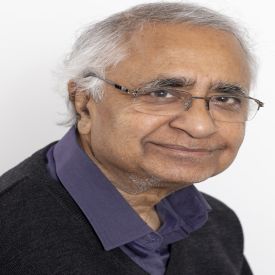Contributor : Profile
Ranjan Ray is Professor of Economics at Monash University in Melbourne, Australia. Ranjan joined Monash University in January 2008 as Professor of Economics from the University of Tasmania. He served as Professor of Economics at the University of Tasmania from 1995 till the beginning of 2008. He also served as Head of Economics at the University of Tasmania from 1995-1998. Prior to that, Ranjan held the position of Professor of Public Economics at the Delhi School of Economics, India from 1989-1995. He moved to Delhi after holding a permanent position in the Department of Econometrics at the University of Manchester in the UK from 1979-1989. He has also held visiting positions at several top ranking academic institutions such as the University of British Columbia and Cornell University.
Ranjan did his undergraduate studies in Presidency College, Calcutta and obtained his B.A. in Economics from the Universityof Calcutta, India. He did his post graduate studies at the Delhi School of Economics, securing his M.A. from Delhi University. He then proceeded to undertake his doctoral studies at the London School of Economics and secured his Ph.D. from London University, U.K. Ranjan has a wide range of research interests that include the specification and estimation of demand systems, the design and reform of commodity taxes, gender bias in consumption patterns, intra household resource allocation, child labour, household poverty and dietary patterns in developing countries, multi-dimensional deprivation, corruption and the informal sector. Ranjan has published widely in a number of highly ranked journals in Economics including The Economic Journal, The Review of Economics and Statistics, Economica, Oxford Economic Papers, European Economic Review, Scandinavian Journal of Economics, Journal of Public Economics, Journal of Development Economics and The Economic Record. He is currently on the Editorial Board of the Economic Record, the official journal of the Economic Society of Australia. He has also been involved in projects funded by the World Bank and the ILO.
Posts by Ranjan Ray
Goods and services tax: Estimating optimal rates
Introduced in India in 2017, a key feature of the goods and services tax (GST) system is that the tax rate for a particular commodity is uniform across the country. Based on a counterfactual framework...
-
 Amita Majumder
Amita Majumder  Ranjan Ray
Ranjan Ray  Sattwik Santra
Sattwik Santra  09 July, 2021
09 July, 2021
- Articles
कोयला आधारित बिजली इकाइयों से प्रदूषण और बच्चों एवं महिलाओं की एनीमिक स्थिति
स्वास्थ्य पर वायु प्रदूषण के प्रभाव को व्यापक रूप से शोध-साहित्य में जगह मिली है। जहां अन्य अध्ययनों में मुख्य रूप से सामान्य रुग्णता और मृत्यु दर जैसे परिणामों पर ध्यान केंद्रित किया गया है, यह लेख ...
-
 Sourangsu Chowdhury
Sourangsu Chowdhury  Gaurav Datt
Gaurav Datt  Sagnik Dey
Sagnik Dey  Pushkar Maitra
Pushkar Maitra  Nidhiya Menon
Nidhiya Menon  Ranjan Ray
Ranjan Ray  07 जनवरी, 2021
07 जनवरी, 2021
- लेख
Pollution from coal-based power units and anaemic status of children and women
An extensive literature has considered the impact of air pollution on health. While studies have mainly focussed on outcomes such as general morbidity and mortality, this article evaluates the impact ...
-
 Sourangsu Chowdhury
Sourangsu Chowdhury  Gaurav Datt
Gaurav Datt  Sagnik Dey
Sagnik Dey  Pushkar Maitra
Pushkar Maitra  Nidhiya Menon
Nidhiya Menon  Ranjan Ray
Ranjan Ray  02 December, 2020
02 December, 2020
- Articles
Child health, fertility, and sex ratio: India vs. Bangladesh
Despite having lower per capita income, Bangladesh has superior performance over India on key welfare indicators. This article compares the experiences of India and Bangladesh on several key indicator...
-
 Salma Ahmed
Salma Ahmed  Aparajita Dasgupta
Aparajita Dasgupta  Ranjan Ray
Ranjan Ray  22 November, 2018
22 November, 2018
- Articles
Enhancing nutrition among the poor: UBI vs. welfare programmes
Some proponents of universal basic income (UBI) for India believe that the unconditional cash transfer should replace existing welfare programmes. Based on analysis of National Sample Survey data, thi...
-
 Ranjan Ray
Ranjan Ray  Kompal Sinha
Kompal Sinha  28 May, 2018
28 May, 2018
- Articles
Quality of governance and welfare outcomes
As the MDGs gave way to the SDGs, considerable attention has been focussed on movements in key welfare indicators for women and children in the past decade. In this context, this column compares India...
-
 Salma Ahmed
Salma Ahmed  Ranjan Ray
Ranjan Ray  27 April, 2016
27 April, 2016
- Perspectives
Why the World Bank's International Comparison Program has limited use for India
Preliminary results from the World Bank’s International Comparison Program, which seeks to compare the economies of 199 countries across the globe, were released recently. In this article, Ranjan R...
-
 Ranjan Ray
Ranjan Ray  20 February, 2015
20 February, 2015
- Perspectives
A critical assessment of the Rangarajan Panel Report on poverty measurement
An expert committee headed by C Rangarajan was appointed by the government to rethink poverty measurement in India. This column provides a critical assessment of the recently released report of the C...
-
 Ranjan Ray
Ranjan Ray  Kompal Sinha
Kompal Sinha  30 October, 2014
30 October, 2014
- Articles
Going beyond the Gujarat versus rest of India debate on growth rates
This column attempts to widen the ongoing growth rates-based debate on ‘Gujarat vs. rest of India’ by ranking Indian states on prices, cost of living, household expenditures and inequality, which...
-
 Ranjan Ray
Ranjan Ray  07 May, 2014
07 May, 2014
- Articles
Economic growth versus social development: The spatial dimension
In the context of the economic growth versus social development debate sparked off by Bhagwati and Sen, this column argues for a more nuanced approach to assessing progress. Combining nationally repre...
-
 Ranjan Ray
Ranjan Ray  31 July, 2013
31 July, 2013
- Articles
Multi-dimensional deprivation in India: Comparisons with China and Vietnam
While several studies have compared India with China on economic measures such as GDP per capita, this column looks at a measure of people’s deprivation across a wide range of indicators. It finds I...
-
 Ranjan Ray
Ranjan Ray  22 October, 2012
22 October, 2012
- Articles




